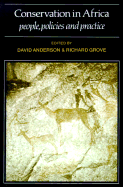Book contents
- Frontmatter
- Contents
- Preface
- List of contributors
- Introduction: The scramble for Eden: past, present and future in African conservation
- Part One Conservation ideologies in Africa
- Part Two Wildlife, Parks and Pastoralist
- Introduction
- 5 Pastoralism, conservation and the overgrazing controversy
- 6 Pastoralists and wildlife: image and reality in Kenya Maasailand
- 7 Integrating parks and pastoralists: some lessons from Amboseli
- 8 The Mursi and National Park development in the Lower Omo Valley
- Part Three Conservation priorities and rural communities
- Part Four Consequences for conservation and development
- Index
5 - Pastoralism, conservation and the overgrazing controversy
Published online by Cambridge University Press: 04 April 2011
- Frontmatter
- Contents
- Preface
- List of contributors
- Introduction: The scramble for Eden: past, present and future in African conservation
- Part One Conservation ideologies in Africa
- Part Two Wildlife, Parks and Pastoralist
- Introduction
- 5 Pastoralism, conservation and the overgrazing controversy
- 6 Pastoralists and wildlife: image and reality in Kenya Maasailand
- 7 Integrating parks and pastoralists: some lessons from Amboseli
- 8 The Mursi and National Park development in the Lower Omo Valley
- Part Three Conservation priorities and rural communities
- Part Four Consequences for conservation and development
- Index
Summary
One striking aspect of the scramble for resources in East Africa has been the interaction of pastoralism and conservation (Homewood & Rodgers, 1984b). The general outcome has been that large areas of pastoral rangelands have been expropriated for exclusive wildlife conservation use (Hjort, 1982; Little, 1984). This has commonly been justified on the argument that pastoralists overstock, overgraze and damage their range while wildlife are seen as existing in harmony with their surroundings. The same argument of environmental misuse and deterioration through pastoralist activities has been and continues to be used as a basis for a variety of land-use development policies. Conventional wisdom now equates pastoralist regimes with overgrazing, though there are differences of opinion as to its underlying cause. Ecologists (exemplified by Lamprey, 1983) see the process as stemming from mismanagement inherent in traditional patterns of communal land tenure combined with individual herd ownership, along the lines of the Tragedy of the Commons(Hardin, 1968). Social scientists tend to attribute it to external constraints – such as compression due to the loss of rangelands to other forms of land use (Hjort, 1982), or the breakdown of traditional controls under outside influence (Bonte, 1976, quoted in Sandford 1983:12; Little, 1981). Although overstocking, overgrazing and desertification may be occurring, too often these processes are simply invoked without evidence to back up their existence; they have become self-reinforcing concepts, with counter examples not infrequently suppressed for political reasons (Sandford, 1983:15).
- Type
- Chapter
- Information
- Conservation in AfricaPeoples, Policies and Practice, pp. 111 - 128Publisher: Cambridge University PressPrint publication year: 1988
- 7
- Cited by



